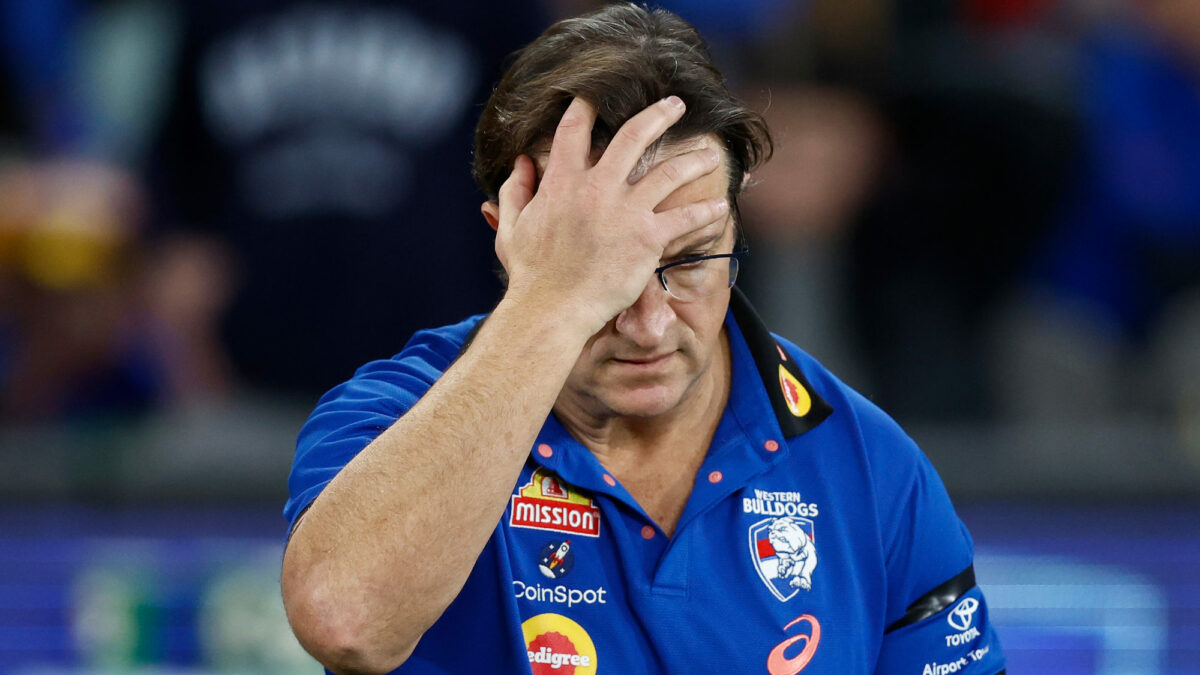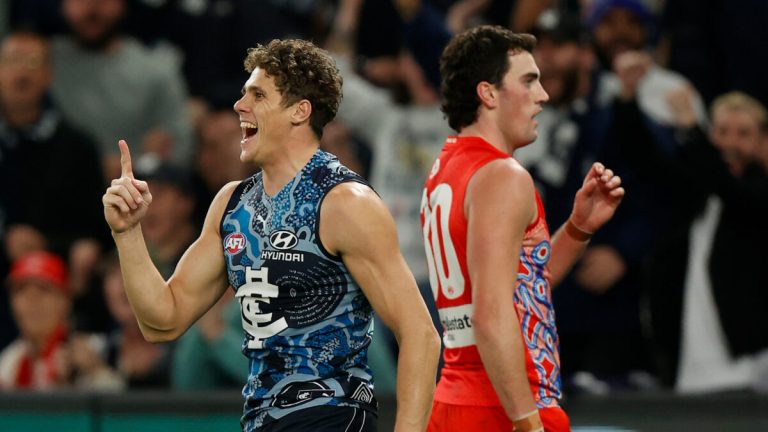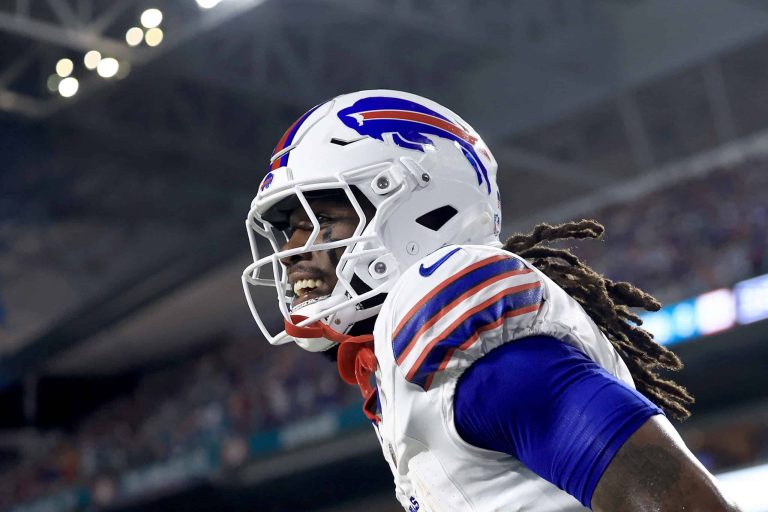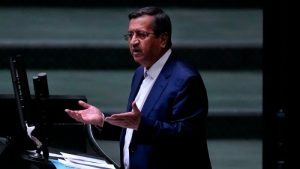The AFL pre-season is done for 2025 – and this one might have been the most dramatic yet.
Finishing on Sunday night less than 100 hours from the start of the season proper, a summer of footy that started with a long-called-for exhibition match and finished with most teams reeling to varying degrees after a spate of injuries has left us with more questions than ever about how the AFL season ahead of us will pan out.
But at the same time… it has answered plenty of other questions, too.
Here are ten things we learned from the AFL Community Series.
The Dogs are cooked already… and Bevo might be too
You can’t win a premiership in February – but you might be able to lose one.
Heading into a crucial season for his coaching future, Luke Beveridge could hardly have been dealt a stiffer hand from the footy gods.
Already, Adam Treloar, Cody Weightman, Liam Jones, Jason Johannisen and Jamarrra Ugle-Hagan were best 22 Bulldogs ruled out of their Round 1 clash with North Melbourne – and in many cases, significantly longer – when the grandaddy of injury blows struck: Marcus Bontempelli sidelined for six weeks after an innocuous calf tweak proved far, far worse than it appeared.
That’s three of the Bulldogs’ top four reigning best-and-fairest placers out – and just for one final kick in the guts, equal-runner-up Bailey Dale and the fifth-placed Ed Richards are both racing the clock to overcome their own niggles in time for a season-opening clash with North Melbourne that now looms as desperately tricky.
It’s the stuff of absolute nightmares, especially for a team many viewed as needing to contend for a premiership for Beveridge to hang onto his job. When you consider that he’s the coach who routinely cops the most stick from some pretty significant talking heads in the AFL media circle, it’s a recipe for disaster.
You can bank on Beveridge not getting an inch of leeway from the likes of Kane Cornes, a long-term critic, for one.
After the Kangaroos, the Bulldogs have Collingwood, Carlton, Fremantle in Perth, Brisbane in Gather Round, St Kilda and GWS in Canberra. 1-6, or even 0-7, is a frighteningly real possibility if they can’t overcome North.
For a team that routinely starts seasons slowly, Bevo, the Bulldogs’ greatest ever coach, is staring down the barrel. Getting through it unscathed might just be his biggest challenge yet.
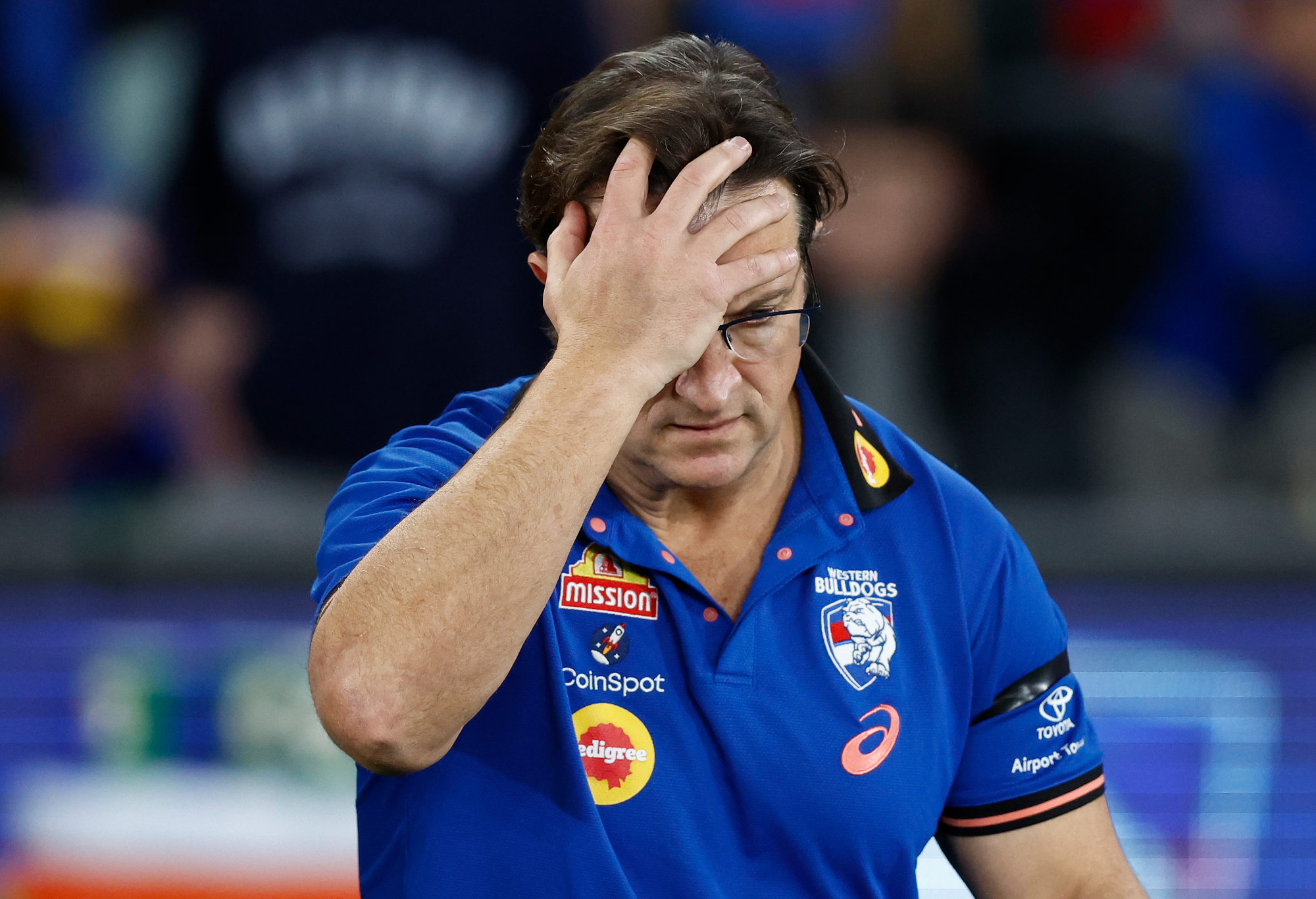
Luke Beveridge. (Photo by Michael Willson/AFL Photos via Getty Images)
Clayton Oliver is BACK
For large parts of their pre-season loss to Fremantle on Sunday night, Melbourne were sloppy, errant, and more than a little rusty.
But that just made Clayton Oliver’s tremendous display stick out even further – and no doubt Dees fans will have been even more thrilled with his performance than they would have been with a win.
It’s no secret the four-time best and fairest winner was well below his best in 2024: after a turbulent off-season, Oliver lacked match fitness, suffered substantial drops both in volume and quality of disposal, and was a major reason why the Dees tumbled all the way down to 14th on the ladder.
The Oliver we saw against the Dockers was a different beast entirely: moving through congestion with his trademark composure and strength, he won a stack of clearances, used the ball sharply, and best of all, hit the scoreboard with three goals – an underrated trait of the star on-baller at his best.
Just 24 disposals is lower than what we’ve come to expect from him, but a team-high XX metres gained was a handy trade-off, and suggests he’s both been given more licence to directly attack after winning the ball rather than using his hands to feed teammates on the outside, and has the fitness base to match.
I wrote in my AFL Oracle piece on the Demons that Oliver’s form was one of the 2021 premiers’ great unknowns heading into the season, and that a return to his best could easily coincide with a surge back up the ladder.
The former is now well and truly on the cards – only time will tell whether the latter will also come to fruition.
Sydney have more depth than we thought
No Isaac Heeney. No Chad Warner. No Brodie Grundy. Barely any Errol Gulden.
And yet a second-string Sydney was still comfortably too slick for a Gold Coast outfit that, pre-season or no, should have backed themselves in every day to knock over the reigning runners-up.
Plenty last year rested on the shoulders of the Swans’ star-studded on-ball quartet, and it was clear that as the season wore on and teams began to work out how to clamp their influence, the irresistible force that was Sydney in the first half of 2024 became decidedly beatable.
Heeney, Warner and Grundy will still be front and centre of the Swans’ push for redemption from last year’s grand final nightmare – as will Gulden if and when he returns from that horror fractured ankle – but from the evidence of the summer, it seems Dean Cox has more depth to work with than originally appeared.
Angus Sheldrick, given sparing opportunities at senior level thus far in his young career, looked the part in a full-time midfield role, with his tenacity for the hard ball particularly impressive; down back, Joel Hamling and new recruit Ben Paton are reliable types who are set to stiffen up a defence that was shredded by Brisbane on the last Saturday in September.
Tom McCartin’s move to the forward line looks a shrewd one, Matt Roberts has taken over from Jake Lloyd as the defensive distributor in chief, and James Jordon showed he has more to offer the Swans than mere tagging responsibilities.
The improvement the Swans need to take the next step in 2025 will need to come as a collective, given no star power was added in the trade period; from the look of things, Cox has the tools at his disposal to uncover it in his maiden season at the helm.
Tom De Koning is ready
The saga of Tom De Koning’s 2024 is one of the more perplexing in the AFL: emerging early in the season as a bona fide breakout contender as a mobile ruckman and capable third tall, he dominated some games, disappeared from others, got injured, and was then recalled for Carlton’s elimination final… as the sub.
Playing as the Blues’ premier ruckman against GWS with Marc Pittonet unavailable, the 25-year old – who Max Gawn reckons will end up as the best player of his generation – was simply masterful as a mobile big man in a performance the champion Demon himself would have been proud of.
More than holding his own in the ruck against a powerful opponent in Kieren Briggs, De Koning ran him ragged around the ground and put him to shame with his follow-up work, with 17 disposals and four clearances made all the more impressive by just 58 per cent game time as the Blues managed his minutes.
Following on from his impressive displays sans Pittonet as a solo ruck in 2024, it was an effort that proves De Koning is ready to officially be the Blues’ number one big man, with only part-time help from a ruck partner like what Lewis Young provided against the Giants.
The Blues have up until now been reluctant to place that burden on his young shoulders, regularly pairing him with Pittonet, who might be a superior ruckman but lacks the extraordinary athletic attributes his younger counterpart has.
At the right age to be breaking into the game’s elite, De Koning is quick, skilled, tough, and now has a powerful frame to match his height.
Give him the keys to the ruck department, Michael Voss, and he might just end the season with a maiden All-Australian blazer. He’s just that good.

Tom De Koning marks in front of Sam De Koning. (Photo by Quinn Rooney/Getty Images)
Freo’s time is now – and Justin Longmuir knows it
Perhaps the most noteworthy aspect of Fremantle’s patchy performance against Melbourne to round out the AFL Community Series was the spray Justin Longmuir is said to have given the Dockers at three-quarter time.
Having showed flashes of brilliance and nailing several aggressive set plays to catch the Demons hopping on the counterattack, with the game firmly in their control at half time, Longmuir had nevertheless seen plenty he didn’t like about their methods – and I’m willing to bet the goals they were leaking at an alarming rate from forward half stoppages was chief among them.
The spray didn’t lead to a dominant last quarter – Freo in fact lost it to let a margin as high as 36 points at half time shrink to 19 at the final siren – but it sums up what many are already suspecting: this, more than any other season since 2015, is Freo’s time.
They have talent to rival any team in the competition, and in all aspects. A strong backline with a solid structure featuring sensible distributors, game-breaking dashers, and key pillars galore. A dynamic midfield with all bases from stoppage grunt work to outside run covered, plus a potential generational ruckman in Luke Jackson and, when he returns, a powerful partner in Sean Darcy. A forward line with keys to spare, nippy pressure players at their heels, and now a genuine game-breaker in the form of new recruit Shai Bolton, who looked every inch the part against the Dees.
And all of it comes against the backdrop of a coach whose fate will now be decided, for a little while at least, in yearly instalments. Little wonder Longmuir felt the need to give them a rev-up nearing the end of a meaningless scratch match well in hand.
Having blown not just top four, but a finals spot altogether, by capitulating in the last three rounds of 2024, this is a team with a point to prove and a list that can prove it.
It’s time for the Dockers to make good.
The Saints are nowhere
On the opposite side of the spectrum we have St Kilda; I’m not sure any supporter base would have come out of their team’s pre-season encounter more deflated than Saints fans after their meek loss to Port Adelaide.
(Actually, Bulldogs fans are far ahead of them in the misery stakes, though for entirely different reasons.)
Since a bright start to Ross Lyon’s second coming in early 2023, the Saints have found themselves embroiled in the same mediocrity that eventually cost Brett Ratten and Alan Richardson before him their jobs.
Lyon is a good enough coach, and the Saints possess enough talent, for them to be far from as bad as the rabble that occupy the lowest rungs of the ladder these days; but even without a casualty ward that now features two of their most exciting young guns in Mattaes Phillipou and Mitch Owens, it’s difficult to see anything to get excited about if you’re a St Kilda supporter.
Port Adelaide, who themselves head into a new season with plenty of questions hanging over them, could hardly have made lighter work of the Saints on Saturday afternoon; in everything from skill, to ferocity, to defending without the ball, they were orders of magnitude superior even without Zak Butters in the team.
With 173 extra disposals and a whopping 140-63 mark discrepancy, the Saints just couldn’t get the ball off Port, with the result that the eventual 44-point margin actually flatters them.
The Saints will be better for having Rowan Marshall back as the number one ruckman, but who knows what Max King’s immediate future holds given his latest round of surgery, and without him and Tim Membrey now at Collingwood, it’s tough to see where the goals will come from for a team that was already struggling to create them.
They have just enough promise to not need a Richmond-style list cull, and – as the saga over Finn Callaghan’s mooted rejection of them encapsulates – remain the very antithesis of a destination club, meaning it’s almost the draft or bust for the top-of-the-line, era-defining talent the Saints need.
Right now, this is a club sitting front and centre in footy’s most unpleasant position: no-man’s land.
There’s life in Dylan Shiel
From injury concerns, to queries about his disposal, to a crop of younger teammates taking his midfield spot, Dylan Shiel has never become the player he was at GWS in his six seasons at Essendon.
But after just 21 games in two seasons, the one-time pure midfielder looks reinvigorated, if still not the finished article yet, in a new role across half-back.
26 disposals and seven marks, if with some rather patchy ball use, was proof of concept that Brad Scott’s ploy with Shiel can work; and with Nic Martin excelling in a new role further up the ground, the spot of running half-back line-breaker is all his to take, and seems to suit the attributes that made him so lethal as a Giant.
No longer needing to compete with the likes of Sam Durham, Jye Caldwell and Ben Hobbs for precious on-baller spots, Shiel’s spot in the best 22 now seems safer than it has been for years.
All but washed up since the end of 2022 – and perhaps for even longer than that – there’s plenty of life in him yet, as it turns out.

Dylan Shiel. (Photo by Quinn Rooney/Getty Images)
The Pies have a new secret weapon
The most high-profile name on last year’s trade radar, Dan Houston was always going to be front and centre of Collingwood’s plan to turn around their finals miss in 2024.
But thinking laterally, Houston’s arrival from Port Adelaide hasn’t stopped Craig McRae from trying a star teammate in a highly similar role alongside him; and Josh Daicos took to half-back like a duck to water against Richmond.
With 27 disposals, 447 metres gained and a cheeky goal, the elder Daicos was even more impactful than the reigning dual All-Australian half-back; his kicking has always been elite, but his composure with ball in hand and defensive pressure are well suited to life in the backline.
With two of the game’s best kicks at his disposal, McRae can now afford to be a bit more daring on the counterattack, the lack of which saw the Magpies’ ability to score from defensive half slow to a trickle in the second half of 2024.
That the Pies want the ball in either of their hands is clear, and having two makes it fiendishly tricky for the opposition to cover all bases with both; one’s typically going to get free.
We expected this sort of quality from Houston, but Daicos being equally effective in the same role is an eye-opener, and one that gives the Magpies’ push for redemption even greater strength.
The people want more representative footy
I’d be surprised if anyone’s major highlight from the 2025 AFL pre-season wasn’t the Indigenous All Stars’ exhibition clash with – and win over – Fremantle.
The football was great, the celebration of Indigenous culture and involvement in our game top-drawer, and with a crowd of nearly 38,000, the paying public lapped it up – yes, it’s smaller than your standard West Coast or Fremantle crowd, but an NRL executive would die of happiness getting that many for a game.
Unlike most of the AFL’s schemes, hinted plans to revive the State of Origin format have been received mostly positively, too. Certainly more so than anything else this pre-season, with most fans just hoping and praying for their stars to get through without major injury.
The one issue with the Indigenous All Stars match was that it was abundantly clear one side took it more seriously than the other, with the Indigenous team desperate to do the jumper proud and Longmuir’s Dockers more concerned with not giving away any gameplan secrets.
Perhaps another exhibition team, or even two or three, would solve both problems at once; allow these teams to face one another rather than actual clubs with bigger fish to fry, and answer the curly question of how to address the issue of having only three states capable of putting together a representative team of any quality.
I’m not entirely sold on keeping an Indigenous team apart from Victorian, South Australian or Western Australian teams – it feels a bit ‘separate but equal’ – but if Shai Bolton and Michael Walters cared for that honour so much as to actually play against their own club, then as far as I’m concerned that team is just as significant, or even more so, as the big V to us Vics.
Four teams. Three games apiece, then a final between the two best-performing if we want it. Do away with the official team versus team pre-season encounters, and leave a gap of two weeks between the last one and the onset of the season, whenever that may be.
Who says no?
Opening Round is too early
I’ve written at length about the injury crisis affecting many of the AFL’s biggest stars this pre-season, and one of the major conclusions I drew was that the newfound closeness of practice matches to the season’s start is a huge factor.
Not only do players get precious little time to recover from any niggles, but the approaching real stuff has brought an intensity to contests that doesn’t fall too short of what we can expect when the real stuff starts – a proper contrast to pre-season games of yore, which for the most part lacked that ferocity.
All of that comes back to the point that Opening Round is dumb: it’s an unnecessary add-on to the season, makes chaos of the opening few rounds, affords some teams the advantage of an extra bye, encroaches on the end of the club cricket season (this is more of a personal bugbear, but still), ruins the anticipation and excitement that once came with Round 1, and is built on a dodgy premise, with the NRL smart enough to schedule their Round 1 fixture to cut off the AFL’s attempts to encroach on their territory.
Next weekend, we have four games on show, with nothing on Saturday night – again giving the NRL a clear swing at it – and not a single game in Victoria, South Australia or Western Australia.
The AFL is a big enough behemoth to do what it wants with little regard for lasting consequences – it’s impossible to make a decision that will bankrupt a league of its magnitude – but the result of that is that there’s a general reluctance to walk back even the silliest ideas and looking foolish for having them in the first place.
Maybe a State of Origin-style tournament will give the AFL enough confidence in dominating the market in February and March to consign Opening Round to the dustbin of history somewhere down the line.
Or maybe not – in which case, the best we can do is to keep bemoaning how dumb it is, even if it falls on deaf ears.
